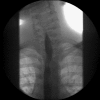Down syndrome and aberrant right subclavian artery
- PMID: 18172685
- PMCID: PMC2491432
- DOI: 10.1007/s00431-007-0637-2
Down syndrome and aberrant right subclavian artery
Abstract
Down syndrome (DS) may be associated with various organ system disorders. Feeding problems are frequent in children with DS and may be caused by associated defects, including congenital heart defects, gastrointestinal defects, or endocrine disorders. In the absence of these associated conditions, feeding problems are often attributed to general hypotonia. However, an aberrant right subclavian artery (ARSA), a rare vascular anomaly and an unusual cause of problems with the passage of solid food through the esophagus, has recently been suggested to occur more frequently in patients with DS. This knowledge is of importance when evaluating feeding difficulties in patients with DS. Additional investigation for identifying an ARSA may be indicated in selected patients. Diagnostic techniques, such as transthoracic echocardiography, barium contrast esophagram, angiography, or computed tomography-angiography (CT) can be used in a diagnostic flow chart. The presence of ARSA is not synonymous to the cause of feeding problems in patients with DS and corrective surgery of this vascular anomaly should be restricted to selected cases.
Figures



Similar articles
-
Feeding problems and gastrointestinal diseases in Down syndrome.Arch Pediatr. 2020 Jan;27(1):53-60. doi: 10.1016/j.arcped.2019.11.008. Epub 2019 Nov 26. Arch Pediatr. 2020. PMID: 31784293 Review.
-
Aberrant right subclavian artery: incidence and correlation with other markers of Down syndrome in second-trimester fetuses.Ultrasound Obstet Gynecol. 2012 Feb;39(2):191-5. doi: 10.1002/uog.10053. Ultrasound Obstet Gynecol. 2012. PMID: 21793087
-
Aberrant right subclavian artery syndrome: a case of chronic cough.J Vasc Surg. 2003 Jun;37(6):1318-21. doi: 10.1016/s0741-5214(02)75464-5. J Vasc Surg. 2003. PMID: 12764282
-
Aberrant right subclavian artery at 11 + 0 to 13 + 6 weeks of gestation in chromosomally normal and abnormal fetuses.Ultrasound Obstet Gynecol. 2008 Jan;31(1):20-4. doi: 10.1002/uog.5226. Ultrasound Obstet Gynecol. 2008. PMID: 18157795
-
Microarray analysis has no additional value in fetal aberrant right subclavian artery: description of 268 pregnancies and systematic literature review.Ultrasound Obstet Gynecol. 2019 Jun;53(6):810-815. doi: 10.1002/uog.20208. Ultrasound Obstet Gynecol. 2019. PMID: 30584678
Cited by
-
Clinical practice. The care of children with Down syndrome.Eur J Pediatr. 2010 Dec;169(12):1445-52. doi: 10.1007/s00431-010-1253-0. Epub 2010 Jul 15. Eur J Pediatr. 2010. PMID: 20632187 Free PMC article. Review.
-
Anomalous origins of bilateral vertebral arteries in a child with Down syndrome and Moyamoya disease. A case report.Interv Neuroradiol. 2012 Sep;18(3):259-63. doi: 10.1177/159101991201800303. Epub 2012 Sep 10. Interv Neuroradiol. 2012. PMID: 22958763 Free PMC article.
-
Neuroimaging assessment in Down syndrome: a pictorial review.Insights Imaging. 2019 May 20;10(1):52. doi: 10.1186/s13244-019-0729-3. Insights Imaging. 2019. PMID: 31111268 Free PMC article. Review.
-
Double aortic arch with double aneuploidy--rare anomaly in combined Down and Klinefelter syndrome.Eur J Pediatr. 2009 Dec;168(12):1479-81. doi: 10.1007/s00431-009-0958-4. Epub 2009 Mar 5. Eur J Pediatr. 2009. PMID: 19263078 Free PMC article.
-
Genetic analysis of Down syndrome-associated heart defects in mice.Hum Genet. 2011 Nov;130(5):623-32. doi: 10.1007/s00439-011-0980-2. Epub 2011 Mar 26. Hum Genet. 2011. PMID: 21442329 Free PMC article.
References
-
- Bayford D. An account of a singular case of obstructed deglutition. Mem Med Soc London. 1794;2:275–280.
-
- Berdon W. Rings, slings, and other things: vascular compression of the infant trachea updated from the mid century to the millenium—the legacy of Robert E. Gross, MD, and Edward B.D. Neuhauser, MD. Radiology. 2000;216:624–632. - PubMed
Publication types
MeSH terms
LinkOut - more resources
Full Text Sources
Medical

